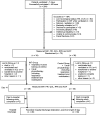Inspiratory muscle training to enhance recovery from mechanical ventilation: a randomised trial
- PMID: 27257003
- PMCID: PMC5013088
- DOI: 10.1136/thoraxjnl-2016-208279
Inspiratory muscle training to enhance recovery from mechanical ventilation: a randomised trial
Abstract
Background: In patients who have been mechanically ventilated, inspiratory muscles remain weak and fatigable following ventilatory weaning, which may contribute to dyspnoea and limited functional recovery. Inspiratory muscle training may improve inspiratory muscle strength and endurance following weaning, potentially improving dyspnoea and quality of life in this patient group.
Methods: We conducted a randomised trial with assessor-blinding and intention-to-treat analysis. Following 48 hours of successful weaning, 70 participants (mechanically ventilated ≥7 days) were randomised to receive inspiratory muscle training once daily 5 days/week for 2 weeks in addition to usual care, or usual care (control). Primary endpoints were inspiratory muscle strength and fatigue resistance index (FRI) 2 weeks following enrolment. Secondary endpoints included dyspnoea, physical function and quality of life, post-intensive care length of stay and in-hospital mortality.
Results: 34 participants were randomly allocated to the training group and 36 to control. The training group demonstrated greater improvements in inspiratory strength (training: 17%, control: 6%, mean difference: 11%, p=0.02). There were no statistically significant differences in FRI (0.03 vs 0.02, p=0.81), physical function (0.25 vs 0.25, p=0.97) or dyspnoea (-0.5 vs 0.2, p=0.22). Improvement in quality of life was greater in the training group (14% vs 2%, mean difference 12%, p=0.03). In-hospital mortality was higher in the training group (4 vs 0, 12% vs 0%, p=0.051).
Conclusions: Inspiratory muscle training following successful weaning increases inspiratory muscle strength and quality of life, but we cannot confidently rule out an associated increased risk of in-hospital mortality.
Trial registration number: ACTRN12610001089022, results.
Keywords: Exercise; Respiratory Measurement; Respiratory Muscles.
Published by the BMJ Publishing Group Limited. For permission to use (where not already granted under a licence) please go to http://www.bmj.com/company/products-services/rights-and-licensing/
Figures




Comment in
-
Recovery from ICU-acquired weakness; do not forget the respiratory muscles!Thorax. 2016 Sep;71(9):779-80. doi: 10.1136/thoraxjnl-2016-208835. Epub 2016 Jul 21. Thorax. 2016. PMID: 27444580 No abstract available.
References
Publication types
MeSH terms
Associated data
LinkOut - more resources
Full Text Sources
Other Literature Sources
Medical
